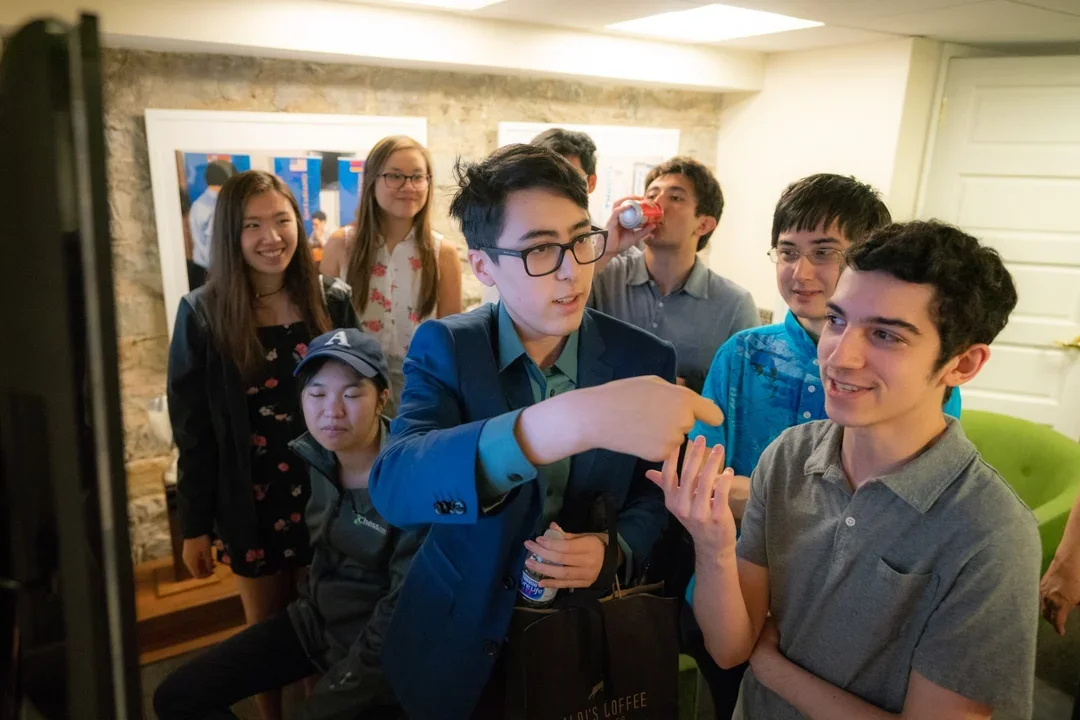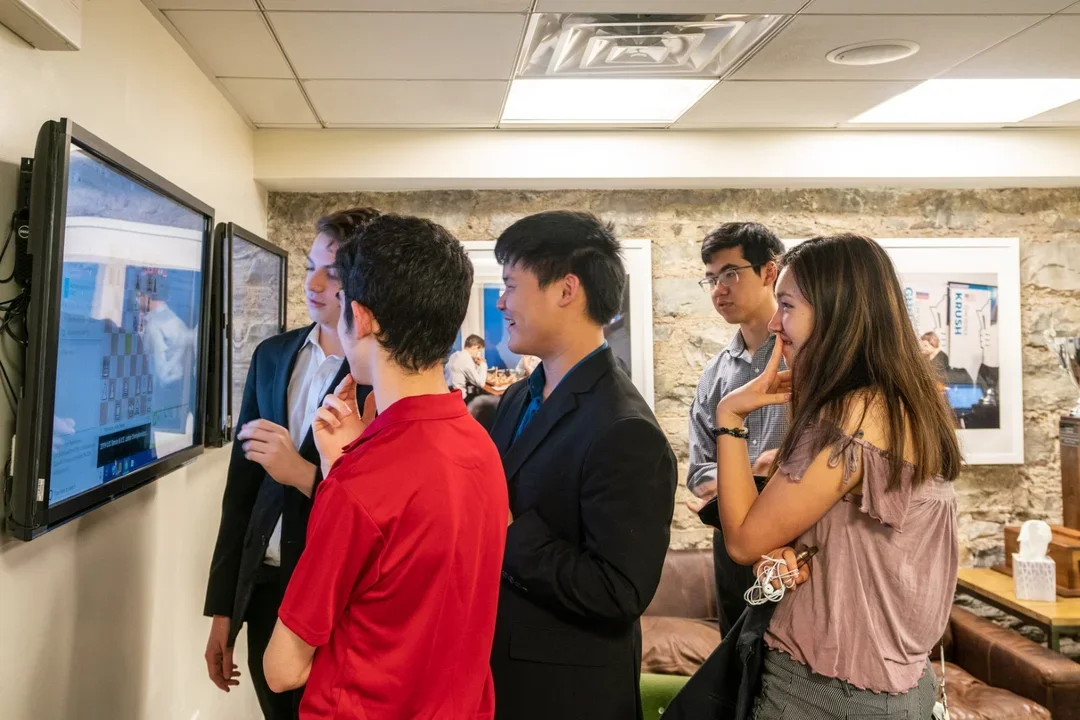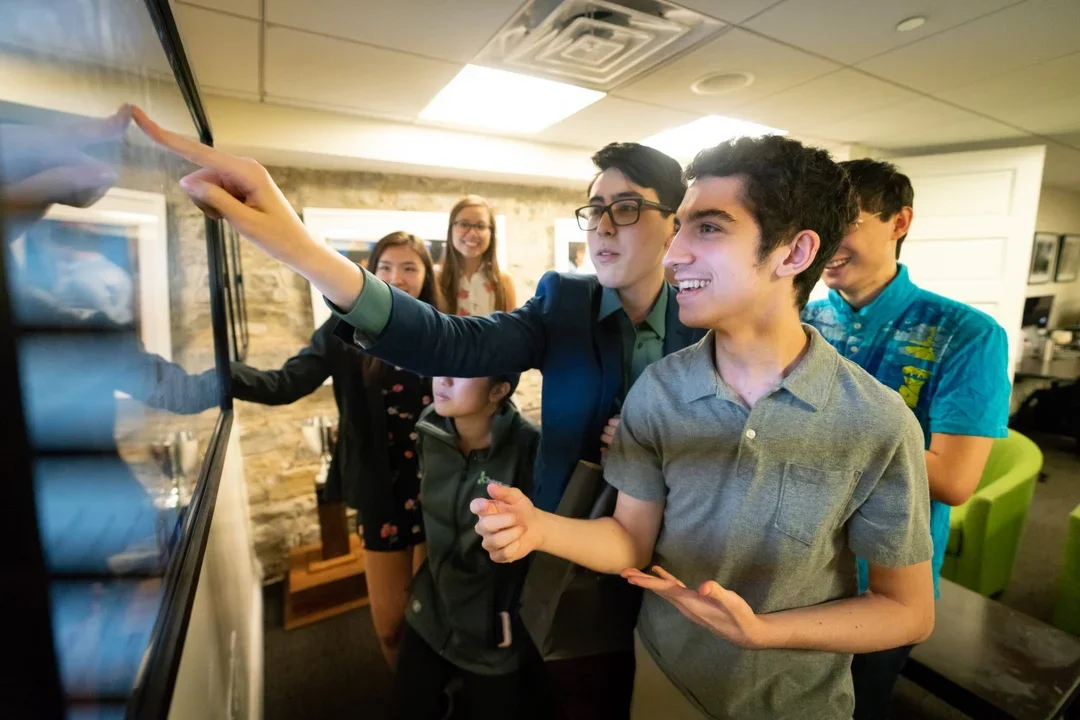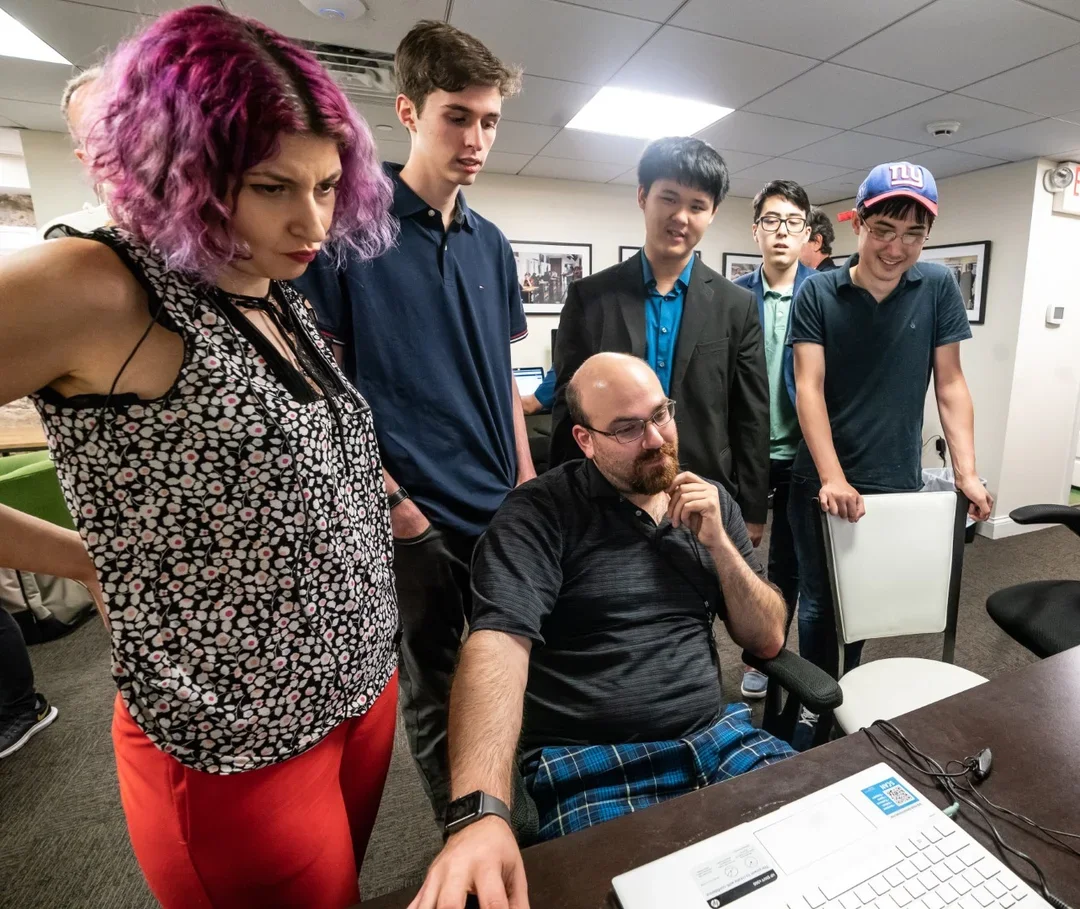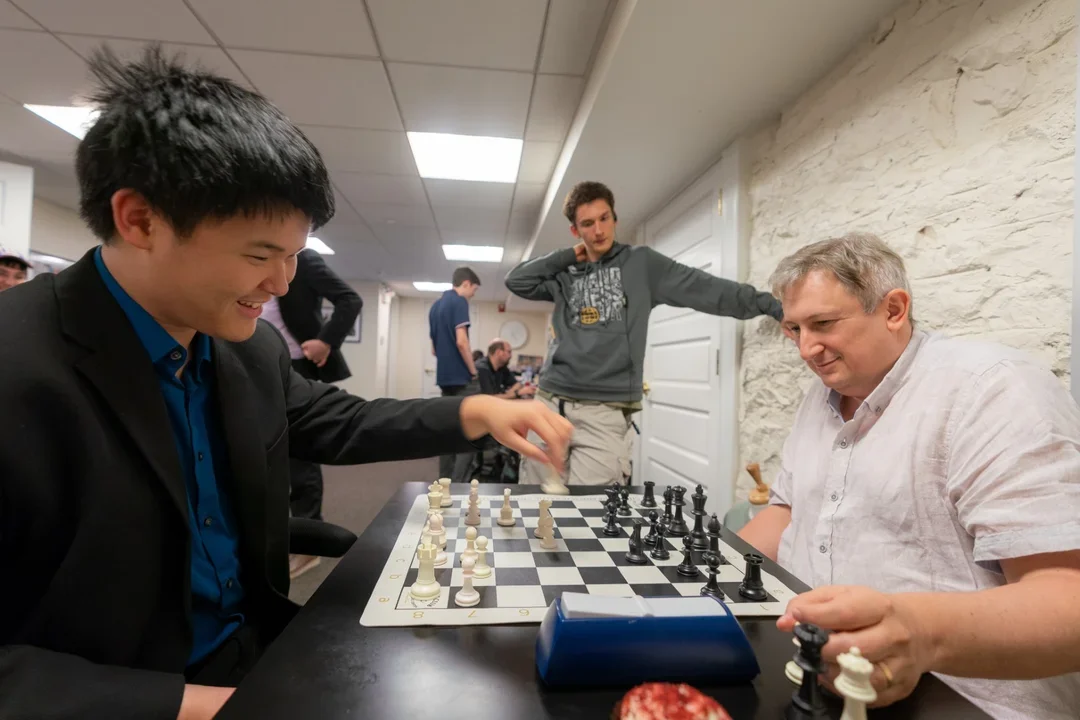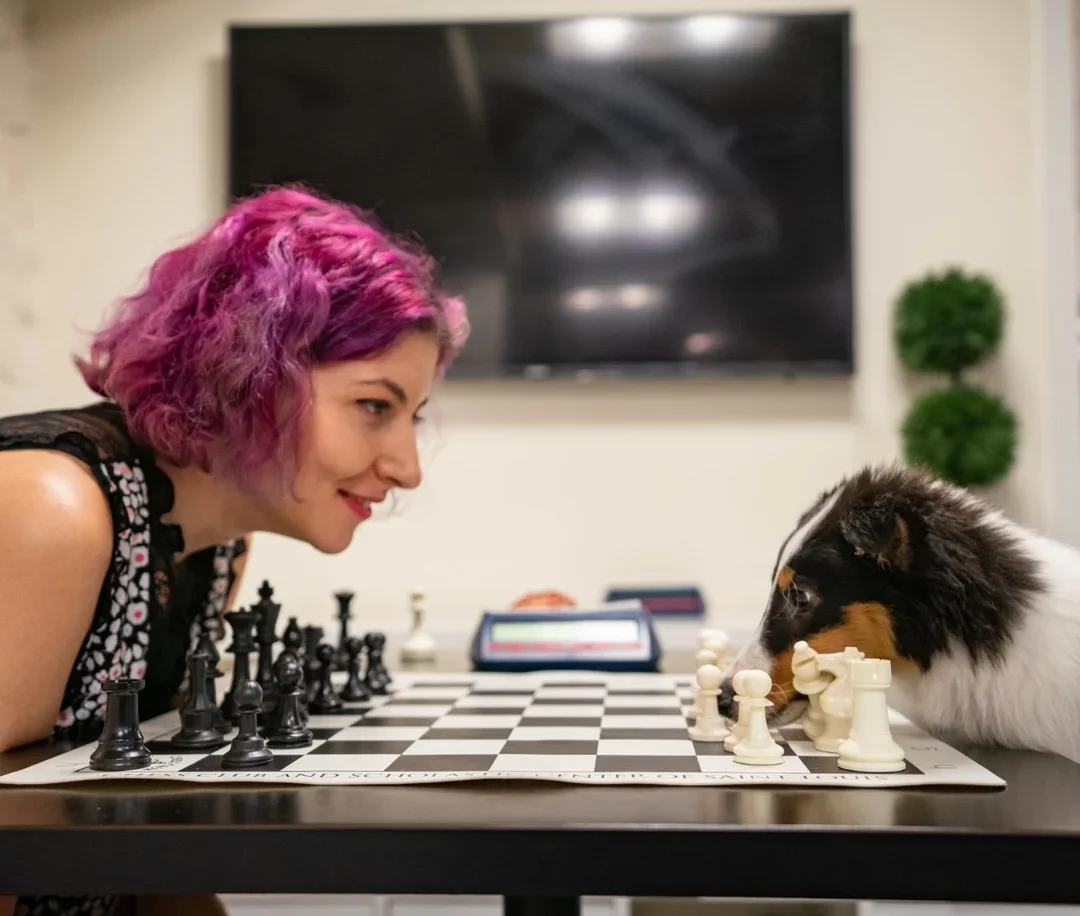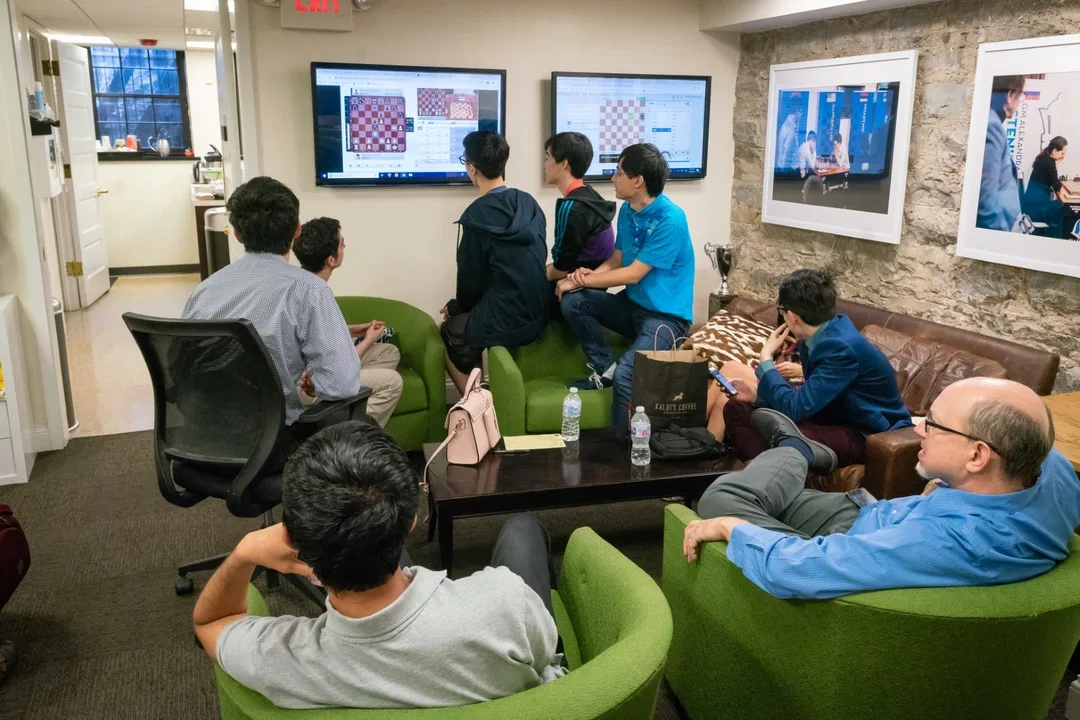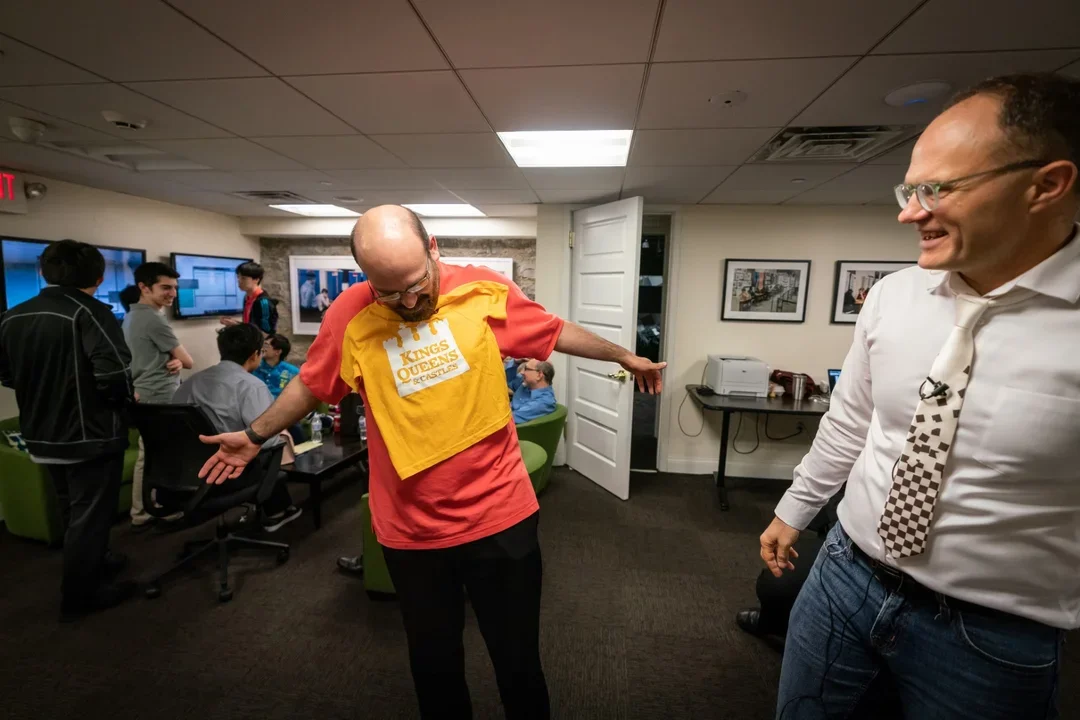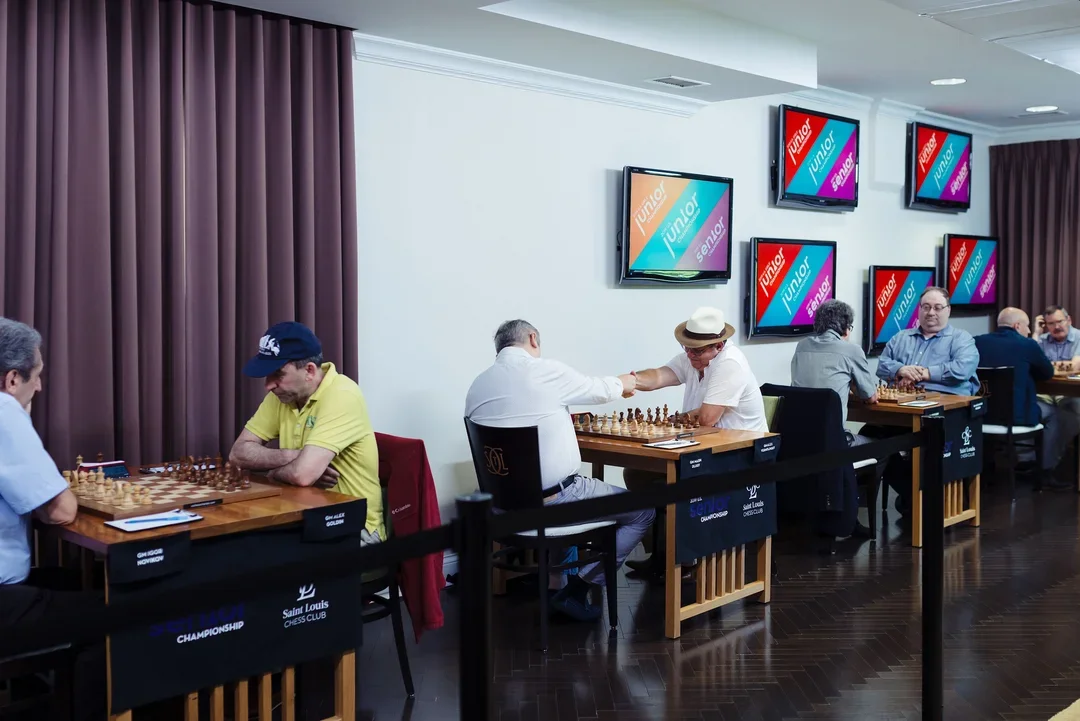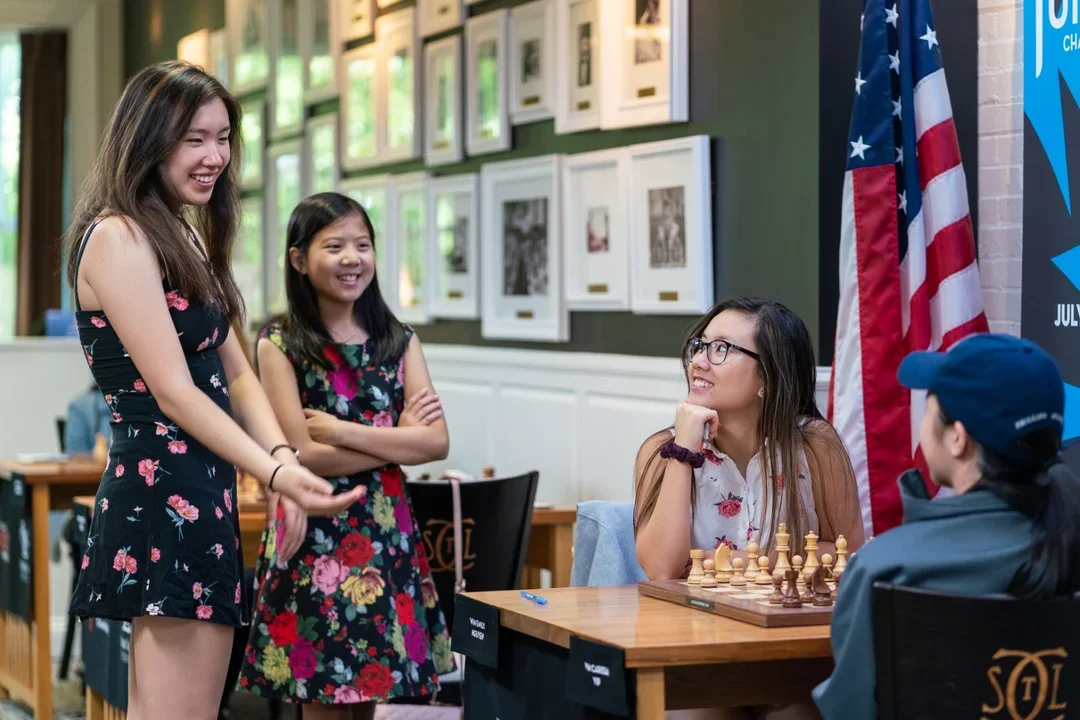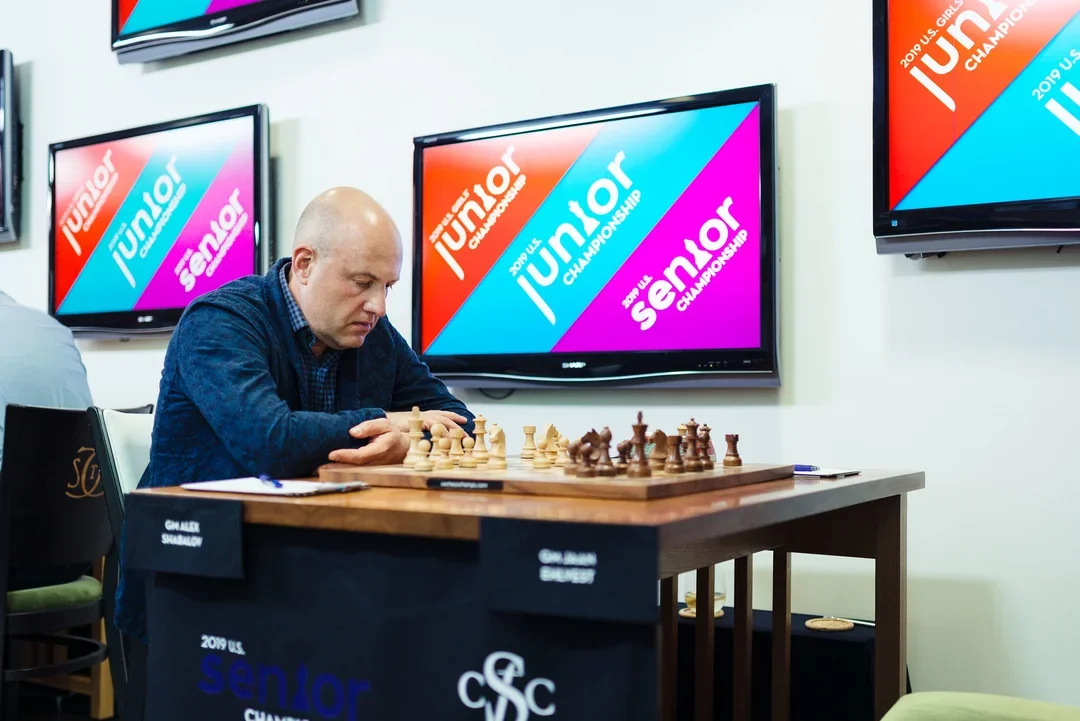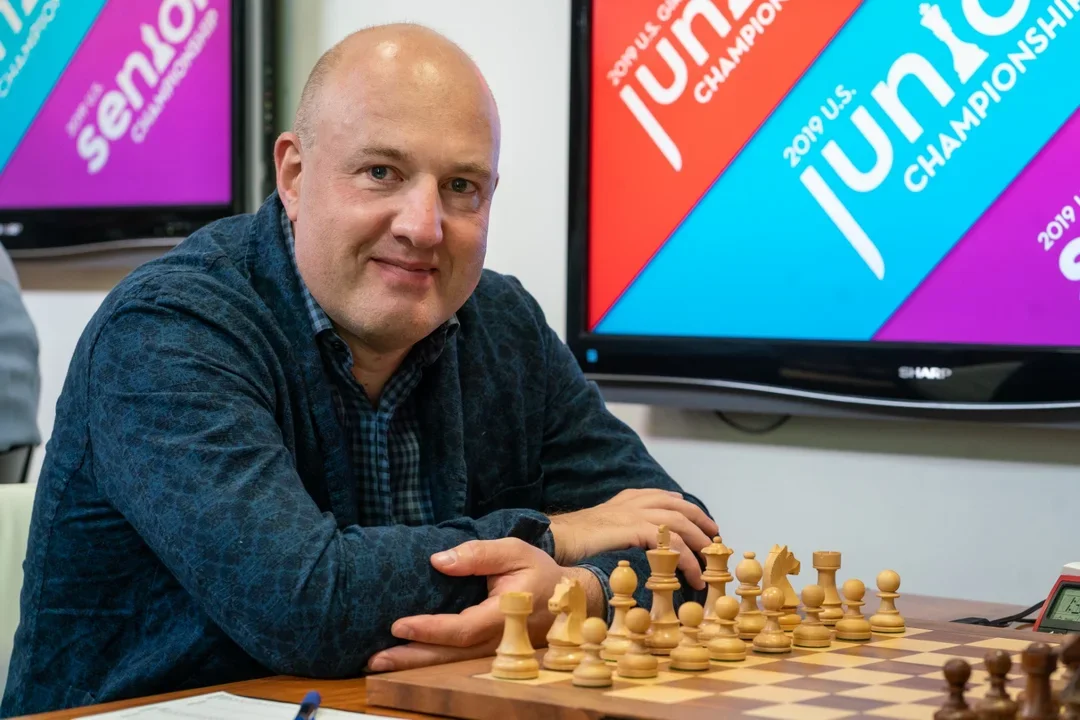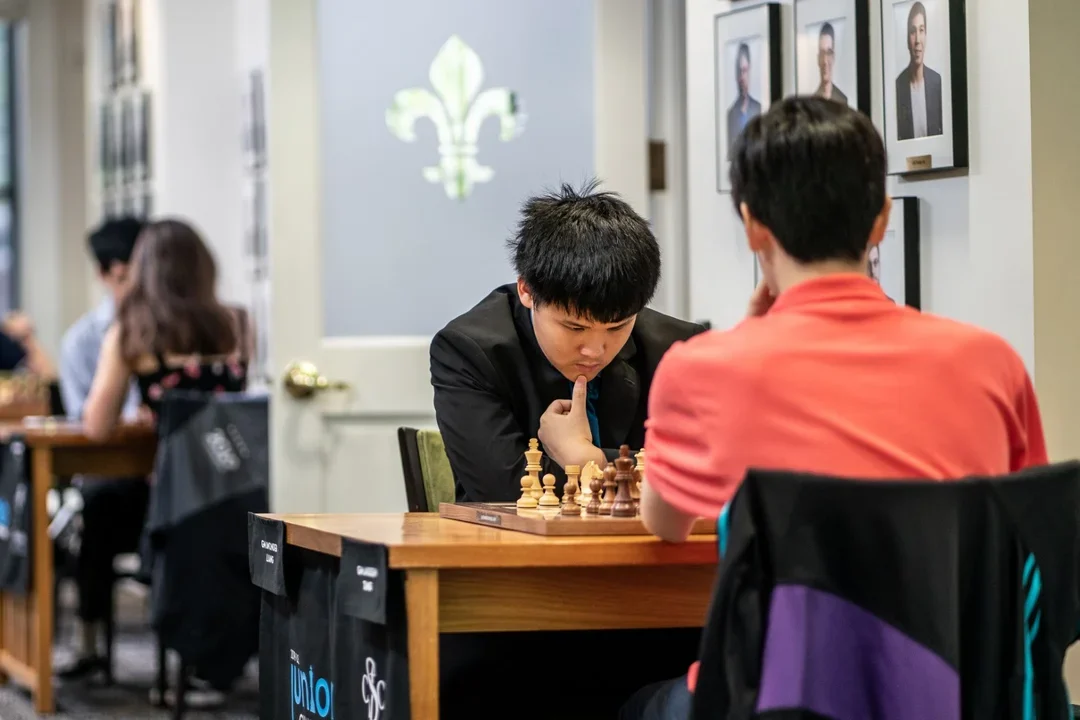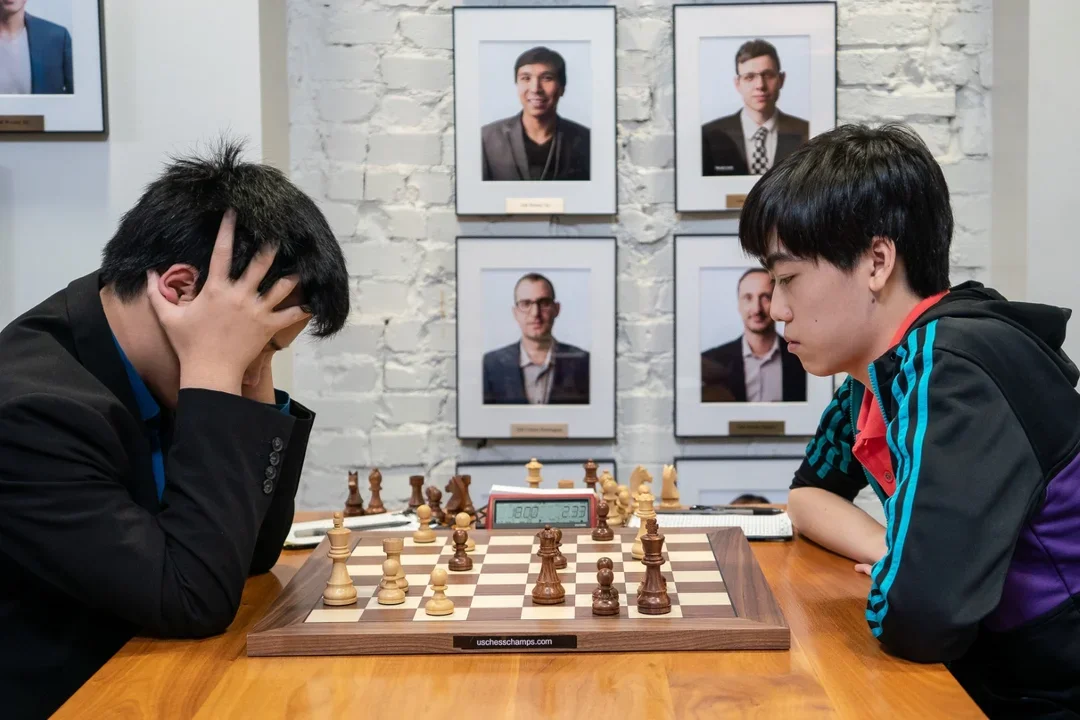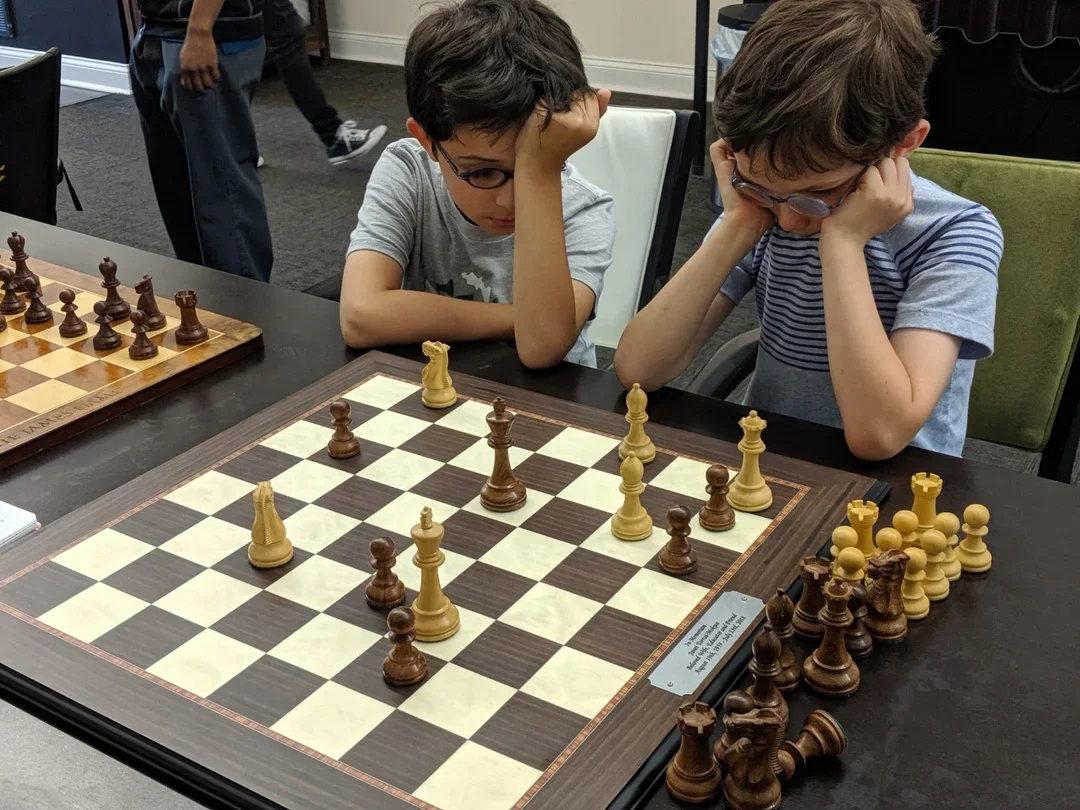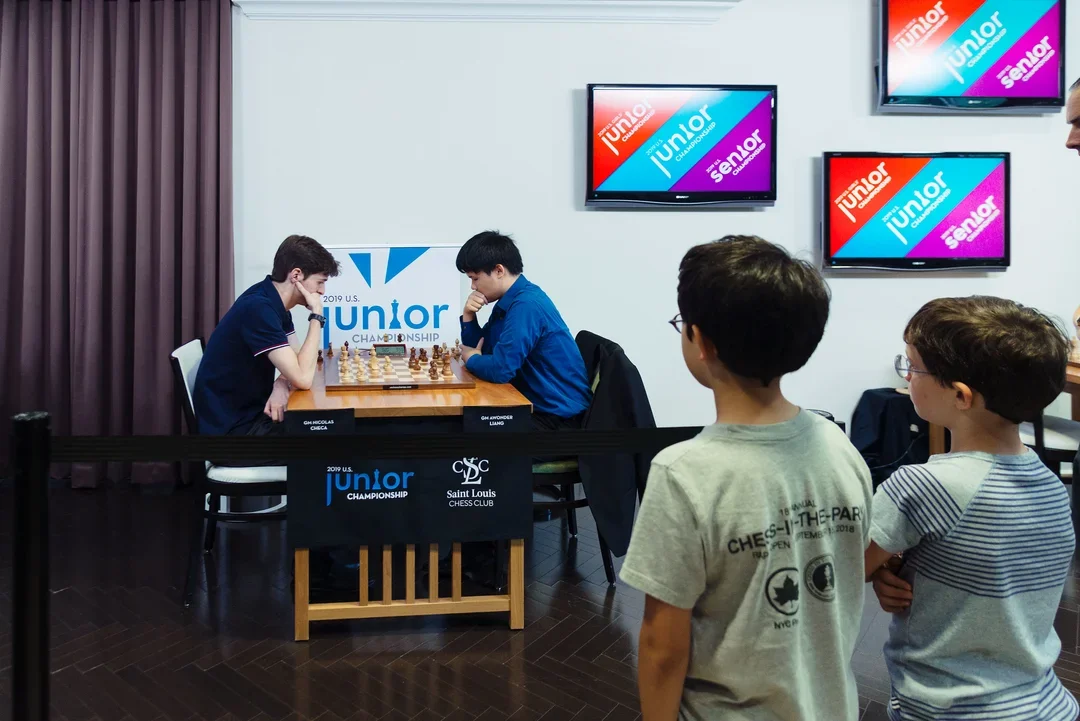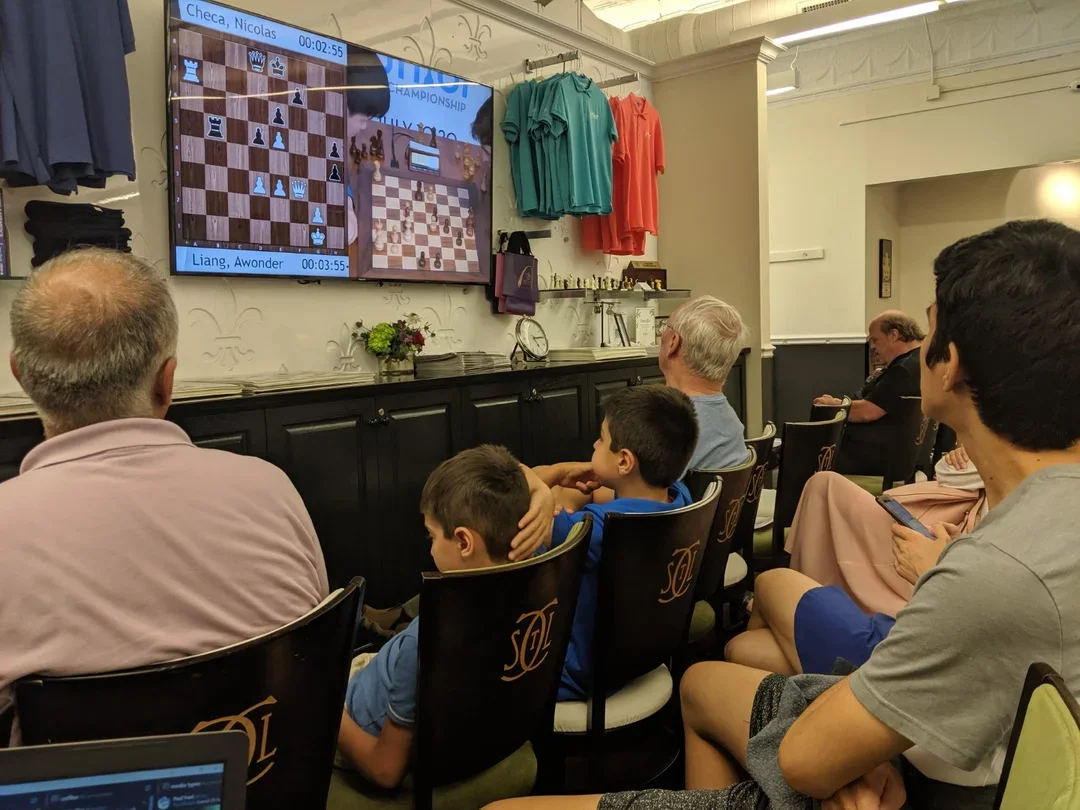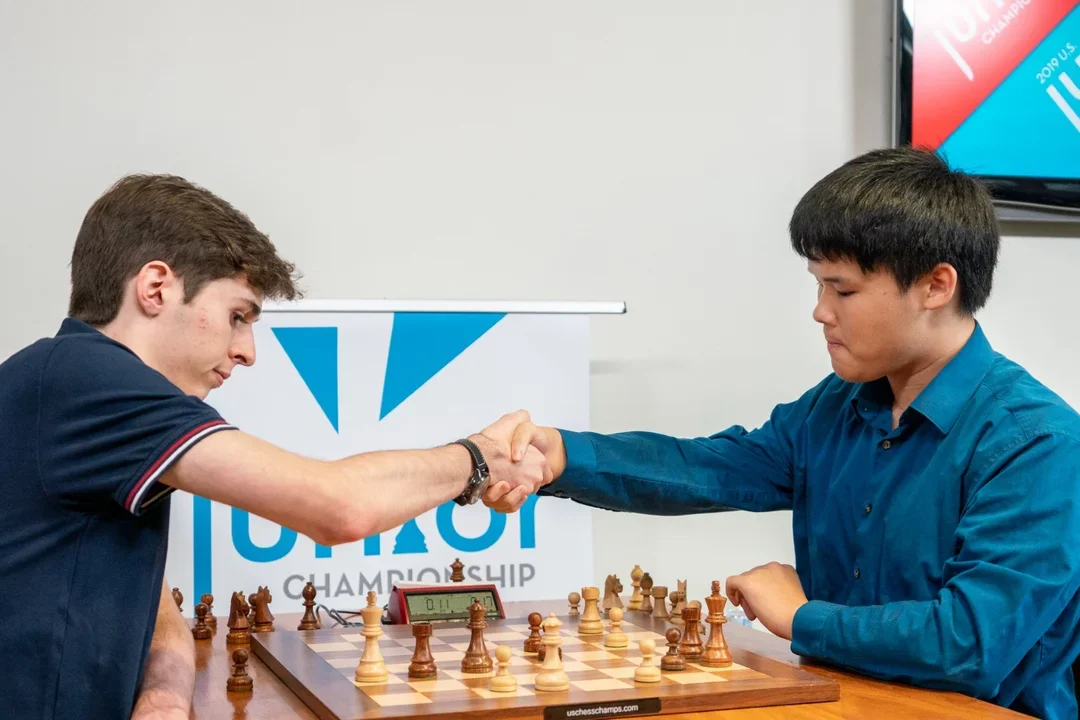There’s a very different feel to the U.S. Juniors (and now Seniors) than is found at the U.S. Championships. It’s not that one is more serious than the other, not exactly. And it’s not quite that the junior and senior players are less serious, because let’s be clear: every single one of the thirty players here at the Junior, Girls, and Senior Championships is utterly, deadly serious about their chess.
What’s different, I think, is the camaraderie and bonhomie. Our top players are all business when playing in the Open and Women’s Championships. Many, if not most, are active professionals, fighting for an impressive cash purse and World Cup bids. They show up at the Club, they play their games, and it’s then back to the hotel to rest and prep for the next day.
Photos from the three Championships this week in Saint Louis paint a different picture with the junior and senior players. They come in to play with and against their friends, having built relationships on Olympiad teams and scholastic championships, in group texts and Goichberg swisses. They hang around in the Club basement after their games end, kibitzing and carousing, laughing and ‘Puzzle Rushing.’
This is a seriousness leavened with the levity of youth and the wisdom of experience. This is a seriousness that knows for all of the competitiveness intrinsic to high-level chess, our game is just that – a beautiful, maddening, absolute rabbit-hole of a game.
To the traditional Junior and “newish” Girls’ Junior Championships, US Chess and the Saint Louis Chess Club this year added a third event. The 2019 U.S. Senior Championship, open to players 50 and above, gave some of America’s ‘more seasoned’ champions the chance for another day in the sun. Having the juniors and seniors in the same place made for fascinating contrast, in terms of openings, playing style, and particularly in the post-game interviews for the livestream. I had chance to watch quite a few of them as I worked on my round reports, and what stood out to me, more than anything, was the difference in how the juniors and seniors analyzed their games. The seniors talked in broad strategic themes, identifying weaknesses, pawn breaks, ideal endgame schemata. Concrete variations were situated in broader insights. Meanwhile the juniors machine-gunned rapidfire analysis, line after line after line. This is a generalization, of course, but the generational gap, the difference between the pre-computer and post-engine worlds, showed itself in stark contrast. I hopped an early-morning flight from Omaha to Saint Louis to witness the final day action, arriving at the Club with about 20 minutes to spare. If you can make the trip, do so. Watching events like these on the livestream is awesome (in the traditional sense of the word), but there is no substitute for getting to walk up those stairs and see elite players ply their trade. The Juniors, Girls, and Seniors each played in one of the three ‘halls’ on the second floor of the Club. The Juniors and Girls were all socializing before the round began. Hans Niemann was talking about something being ‘money well spent,’ and Jennifer Yu was over on the Girls side, huddled with her friends. For their part, the Seniors were seated, serious faces all around, looking like adults who know the importance of prize money and mortgage payments. With both Carissa Yip leading the Girls Championship and Alex Shabalov leading the Senior by a full point heading into the round, most of the attention was focused on the Junior Championship, where Nico Checa and Awonder Liang were tied at the top of the table. The thought was that Shabalov and Yip would draw quickly, ensuring their titles, while Checa and Liang would have to play their games with one eye on each other’s boards. Shabalov quickly fulfilled his end of the bargain, carefully working his way to a draw against Jaan Ehlvest in just over the minimum 30 moves. This earned him $12,000 for first place in the Senior Championship.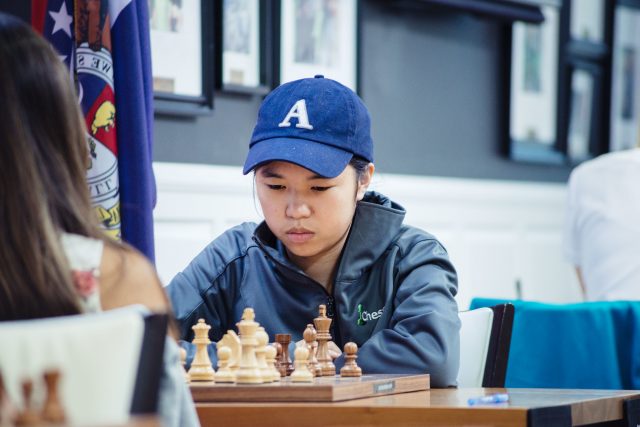 Carissa Yip (photo Crystal Fuller)
Carissa Yip (photo Crystal Fuller)
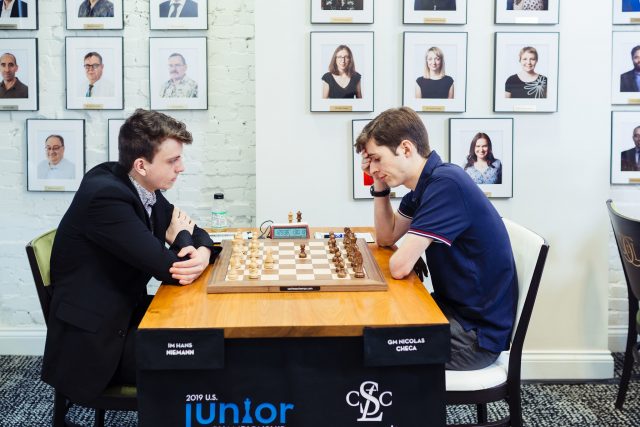 Niemann-Checa (photo Crystal Fuller)
Niemann-Checa (photo Crystal Fuller)
 Zilajeva-Li (photo Eric Rosen)
Still, I think it fair to say that attention downstairs at the club waned a bit as we waited the two hours for the playoff. Club regulars banged out blitz games. Staff members gave lessons. And I spent a bit of time with two young players from New York, whom I tortured with mate in twos.
Luc Cacciatore (9) and his brother Max (“almost 7”) are competitive and ambitious. Studying with Coach Angel (Lopez) and Coach Shawn (Martinez) from Impact Coaching Network – the same outfit that helped Tani Adewumi reach such famous heights this spring – the boys play tournaments almost every weekend, their mom told me, and they just finished a camp in NYC with Sam Shankland.
The boys challenged me to blitz, but discretion being the better part of valor, I demurred, preferring to challenge them to solve some mate in twos. “This’ll be easy!,” the boys boasted.
They were wrong. Here’s an example of the cruelty I inflicted upon these brave young lads. It’s the position shown in the picture above.
Zilajeva-Li (photo Eric Rosen)
Still, I think it fair to say that attention downstairs at the club waned a bit as we waited the two hours for the playoff. Club regulars banged out blitz games. Staff members gave lessons. And I spent a bit of time with two young players from New York, whom I tortured with mate in twos.
Luc Cacciatore (9) and his brother Max (“almost 7”) are competitive and ambitious. Studying with Coach Angel (Lopez) and Coach Shawn (Martinez) from Impact Coaching Network – the same outfit that helped Tani Adewumi reach such famous heights this spring – the boys play tournaments almost every weekend, their mom told me, and they just finished a camp in NYC with Sam Shankland.
The boys challenged me to blitz, but discretion being the better part of valor, I demurred, preferring to challenge them to solve some mate in twos. “This’ll be easy!,” the boys boasted.
They were wrong. Here’s an example of the cruelty I inflicted upon these brave young lads. It’s the position shown in the picture above.
US Junior/Senior/Girls Quick Links: Official STL Chess Club YouTube Live on uschesschamps.com Pairings & Results US Junior Pairings & Results US Senior Pairings & Results US Girls
To the traditional Junior and “newish” Girls’ Junior Championships, US Chess and the Saint Louis Chess Club this year added a third event. The 2019 U.S. Senior Championship, open to players 50 and above, gave some of America’s ‘more seasoned’ champions the chance for another day in the sun. Having the juniors and seniors in the same place made for fascinating contrast, in terms of openings, playing style, and particularly in the post-game interviews for the livestream. I had chance to watch quite a few of them as I worked on my round reports, and what stood out to me, more than anything, was the difference in how the juniors and seniors analyzed their games. The seniors talked in broad strategic themes, identifying weaknesses, pawn breaks, ideal endgame schemata. Concrete variations were situated in broader insights. Meanwhile the juniors machine-gunned rapidfire analysis, line after line after line. This is a generalization, of course, but the generational gap, the difference between the pre-computer and post-engine worlds, showed itself in stark contrast. I hopped an early-morning flight from Omaha to Saint Louis to witness the final day action, arriving at the Club with about 20 minutes to spare. If you can make the trip, do so. Watching events like these on the livestream is awesome (in the traditional sense of the word), but there is no substitute for getting to walk up those stairs and see elite players ply their trade. The Juniors, Girls, and Seniors each played in one of the three ‘halls’ on the second floor of the Club. The Juniors and Girls were all socializing before the round began. Hans Niemann was talking about something being ‘money well spent,’ and Jennifer Yu was over on the Girls side, huddled with her friends. For their part, the Seniors were seated, serious faces all around, looking like adults who know the importance of prize money and mortgage payments. With both Carissa Yip leading the Girls Championship and Alex Shabalov leading the Senior by a full point heading into the round, most of the attention was focused on the Junior Championship, where Nico Checa and Awonder Liang were tied at the top of the table. The thought was that Shabalov and Yip would draw quickly, ensuring their titles, while Checa and Liang would have to play their games with one eye on each other’s boards. Shabalov quickly fulfilled his end of the bargain, carefully working his way to a draw against Jaan Ehlvest in just over the minimum 30 moves. This earned him $12,000 for first place in the Senior Championship.
[pgn] [Event "2019 U.S. Senior Championship"] [Site "?"] [Date "2019.07.20"] [Round "9.1"] [White "Shabalov, Alexander"] [Black "Ehlvest, Jaan"] [Result "1/2-1/2"] [ECO "E95"] [PlyCount "63"] [EventDate "2019.??.??"] 1. d4 Nf6 2. c4 g6 3. Nc3 Bg7 4. e4 d6 5. Nf3 O-O 6. Be2 Nbd7 7. O-O e5 8. Re1 Re8 9. Bf1 a6 10. Rb1 exd4 11. Nxd4 c6 12. Bf4 Ne5 13. h3 Bd7 14. Qd2 Qc7 15. a3 Nh5 16. Be3 b5 17. cxb5 axb5 18. Be2 Nf6 19. Rbd1 Qb7 20. Bf4 d5 21. Bxe5 Rxe5 22. exd5 Nxd5 23. Ndxb5 Be6 24. Nd4 Nxc3 25. bxc3 Rxa3 26. Bf3 Rxe1+ 27. Qxe1 Bxd4 28. cxd4 Qd7 29. Qe5 Ra8 30. d5 cxd5 31. Bxd5 Bxd5 32. Qxd5 1/2-1/2 [/pgn]Yip had to do a bit more work to earn her second Girls’ Junior title. Playing Black against Emily Nguyen, Yip found herself in a worse position in the middlegame, but managed to work her way back to a draw… even if it looked a little dicey at times!
 Carissa Yip (photo Crystal Fuller)
Carissa Yip (photo Crystal Fuller)[pgn] [Event "2019 U.S. Girls Championship"] [Site "?"] [Date "2019.07.20"] [Round "9.3"] [White "Nguyen, Emily"] [Black "Yip, Carissa"] [Result "1/2-1/2"] [ECO "A40"] [PlyCount "93"] [EventDate "2019.??.??"] 1. d4 g6 2. c4 Bg7 3. Nc3 Nf6 4. Nf3 O-O 5. g3 d5 6. cxd5 Nxd5 7. Bg2 Nb6 8. O-O Nc6 9. d5 Na5 10. Qc2 c6 11. dxc6 Nxc6 12. Rd1 Qe8 13. Qe4 e5 14. Qh4 Qe7 15. Qxe7 Nxe7 16. Be3 Nc6 17. Nb5 e4 18. Nfd4 Nc4 19. Bxe4 Nxe3 20. fxe3 Bh6 21. Nxc6 Bxe3+ 22. Kg2 bxc6 23. Bxc6 Rb8 24. Rd3 Bh6 25. b3 Rb6 26. Nxa7 Bf5 27. e4 Rxc6 28. exf5 Rc2+ 29. Kh3 Ra8 30. Nb5 Bg7 31. f6 Bxf6 32. Rf1 Raxa2 33. Rxf6 h5 34. Kh4 Rc5 35. h3 Rxb5 36. Rd7 Re2 37. Rdxf7 Re4+ 38. g4 Re8 39. Ra7 hxg4 40. Rxg6+ Kh8 41. hxg4 Rxb3 42. Rc6 Rb1 43. g5 Rh1+ 44. Kg4 Rg1+ 45. Kh5 Rh1+ 46. Kg4 Rg1+ 47. Kh5 1/2-1/2 [/pgn]For her efforts, Yip received a $3,000 first prize and a $10,000 scholarship to the college of her choice from the Dewain Barber Foundation and US Chess. This left the matter of the Junior Championship, where Nico Checa had Black against Hans Niemann, and Awonder Liang played with White against Andrew Tang. By 2pm – the round started early at 11am to accommodate a potential playoff and closing ceremony – Checa had drawn with Niemann, opening the door for Liang to take the title by winning against Tang.
 Niemann-Checa (photo Crystal Fuller)
Niemann-Checa (photo Crystal Fuller)[pgn] [Event "2019 U.S. Junior Championship"] [Site "?"] [Date "2019.07.20"] [Round "9.5"] [White "Niemann, Hans Moke"] [Black "Checa, Nicolas"] [Result "1/2-1/2"] [ECO "A06"] [PlyCount "60"] [EventDate "2019.??.??"] 1. Nf3 d5 2. e3 Nf6 3. c4 c6 4. Nc3 a6 5. d4 b5 6. cxd5 cxd5 7. Bd3 e6 8. a4 b4 9. Ne2 Nc6 10. b3 Bd6 11. Bb2 Bb7 12. O-O O-O 13. Ng3 a5 14. Rc1 Ne7 15. Ne5 Ba6 16. Bxa6 Rxa6 17. Qd3 Ra8 18. Qb5 Rb8 19. Qa6 Ra8 20. Qb5 Rb8 21. Qa6 Qb6 22. Qxb6 Rxb6 23. Rc2 Rc8 24. Rxc8+ Nxc8 25. Rc1 Ne7 26. Nd3 Kf8 27. f3 Ke8 28. Kf2 h5 29. Nf1 Rc6 30. Rxc6 Nxc6 1/2-1/2 [/pgn]Andrew Tang, however, had other ideas. He managed to get a winning position before missing an equalizing shot on move 35, one that Liang grabbed like a life preserver. Their game was drawn at about 2:35pm, setting up a playoff between Checa and Liang at 5pm.
[pgn] [Event "2019 U.S. Junior Championship"] [Site "?"] [Date "2019.07.20"] [Round "9.2"] [White "Liang, Awonder"] [Black "Tang, Andrew"] [Result "1/2-1/2"] [ECO "C60"] [PlyCount "77"] [EventDate "2019.??.??"] 1. e4 e5 2. Nf3 Nc6 3. Bb5 g6 4. d4 exd4 5. c3 a6 6. Ba4 Bg7 7. cxd4 b5 8. Bc2 d6 9. h3 Nf6 10. O-O O-O 11. Nc3 Bb7 12. Re1 Re8 13. Bg5 h6 14. Bd2 Na5 15. Qc1 Kh7 16. b3 b4 17. Na4 Bxe4 18. Bxe4 Nxe4 19. Bxb4 c5 20. Bxa5 Qxa5 21. Qc4 Nd2 22. Nxd2 Qxd2 23. Red1 Qf4 24. Rd3 Ra7 25. Rf1 cxd4 26. Nb6 Qf5 27. Rdd1 Qc5 28. Qa4 Re2 29. Nc4 d5 30. Nd2 Qc2 31. Nf3 Rxf2 32. Rxf2 Qxd1+ 33. Kh2 Qc1 34. Qa5 Qf4+ 35. Kg1 Rc7 36. Ng5+ Qxg5 37. Qxc7 d3 38. Rxf7 Qe3+ 39. Kf1 1/2-1/2 [/pgn]It is a bit of a shame that the playoff overshadowed some of the outstanding games played in the final round. The last two games to finish, for instance, made for terrific TV. Could Larry Christiansen find a way to convert against Joel Benjamin? Would Veronika Zilajeva mate Rachael Li with bishop and knight within 50 moves? (The answer to both questions, by the way, was yes.)
 Zilajeva-Li (photo Eric Rosen)
Zilajeva-Li (photo Eric Rosen)[pgn] [Event "(Original)"] [Site "?"] [Date "2001.??.??"] [Round "?"] [White "Pervakov, Rezvov, Tkachenko"] [Black "#2"] [Result "1-0"] [SetUp "1"] [FEN "8/2p5/2Kp1N2/8/8/pB1k2p1/p7/Q1B3N1 w - - 0 1"] [PlyCount "3"] [EventDate "2001.??.??"] [SourceTitle "190519"] [SourceDate "2019.05.19"] [SourceVersion "1"] [SourceVersionDate "2019.05.19"] [SourceQuality "1"] 1. Ne4 Kxe4 (1... d5 2. Nc5#) (1... g2 2. Nf2#) 2. Bc2# 1-0 [/pgn]Soon Luc and Max were bounding up the stairs to watch the remaining games, having heard my admonition “don’t move the pieces to solve it!” one time too many. I grabbed a chair and a coffee, fired up my laptop, and got ready for the playoff to begin. I wasn’t alone. Mysteriously, almost imperceptibly, friends and fans filled the first floor of the Saint Louis Chess Club as Checa and Liang began to play. Rex Sinquefield appeared, taking his customary seat right in front of the big screen. Veronika Zijaleva sat right behind him. Behind me was the "circa-1976 Junior Spartakiad” team of Max Dlugy, Jaan Ehlvest, and Alex Yermolinsky. As things turned out, and as CLO readers already know, Liang won both rapid games to win the tiebreak, giving him the title of U.S. Junior Champion for the third consecutive year. With this comes a seat in the 2020 U.S. Championship, a $6,000 first prize, and a $10,000 scholarship courtesy of the Dewain Barber Foundation and US Chess. With the tournament finally over, the first floor emptied just as quickly as it had filled. The players rushed down the street to the Closing Ceremony for dinner and age-appropriate beverages. And then? https://twitter.com/IMCryptochess/status/1152714588225515520 Age against youth. Experience against energy. And always, always, always bughouse. A fitting end to a fine event. I'm very much looking forward to next year’s edition.
US Junior/Senior/Girls Quick Links: Official STL Chess Club YouTube Live on uschesschamps.com Pairings & Results US Junior Pairings & Results US Senior Pairings & Results US Girls
Categories
Archives
- December 2025 (27)
- November 2025 (29)
- October 2025 (39)
- September 2025 (27)
- August 2025 (29)
- July 2025 (43)
- June 2025 (25)
- May 2025 (24)
- April 2025 (29)
- March 2025 (29)
- February 2025 (20)
- January 2025 (24)
- December 2024 (34)
- November 2024 (18)
- October 2024 (35)
- September 2024 (23)
- August 2024 (27)
- July 2024 (44)
- June 2024 (27)
- May 2024 (31)
- April 2024 (51)
- March 2024 (34)
- February 2024 (25)
- January 2024 (26)
- December 2023 (29)
- November 2023 (26)
- October 2023 (37)
- September 2023 (27)
- August 2023 (37)
- July 2023 (47)
- June 2023 (33)
- May 2023 (37)
- April 2023 (45)
- March 2023 (37)
- February 2023 (28)
- January 2023 (31)
- December 2022 (23)
- November 2022 (32)
- October 2022 (31)
- September 2022 (19)
- August 2022 (39)
- July 2022 (32)
- June 2022 (35)
- May 2022 (21)
- April 2022 (31)
- March 2022 (33)
- February 2022 (21)
- January 2022 (27)
- December 2021 (36)
- November 2021 (34)
- October 2021 (25)
- September 2021 (25)
- August 2021 (41)
- July 2021 (36)
- June 2021 (29)
- May 2021 (29)
- April 2021 (31)
- March 2021 (33)
- February 2021 (28)
- January 2021 (29)
- December 2020 (38)
- November 2020 (40)
- October 2020 (41)
- September 2020 (35)
- August 2020 (38)
- July 2020 (36)
- June 2020 (46)
- May 2020 (42)
- April 2020 (37)
- March 2020 (60)
- February 2020 (38)
- January 2020 (45)
- December 2019 (34)
- November 2019 (35)
- October 2019 (42)
- September 2019 (45)
- August 2019 (56)
- July 2019 (44)
- June 2019 (35)
- May 2019 (40)
- April 2019 (48)
- March 2019 (61)
- February 2019 (39)
- January 2019 (30)
- December 2018 (29)
- November 2018 (51)
- October 2018 (45)
- September 2018 (29)
- August 2018 (49)
- July 2018 (35)
- June 2018 (31)
- May 2018 (39)
- April 2018 (31)
- March 2018 (26)
- February 2018 (33)
- January 2018 (30)
- December 2017 (26)
- November 2017 (24)
- October 2017 (30)
- September 2017 (30)
- August 2017 (31)
- July 2017 (28)
- June 2017 (32)
- May 2017 (26)
- April 2017 (37)
- March 2017 (28)
- February 2017 (30)
- January 2017 (27)
- December 2016 (29)
- November 2016 (24)
- October 2016 (32)
- September 2016 (31)
- August 2016 (27)
- July 2016 (24)
- June 2016 (26)
- May 2016 (19)
- April 2016 (30)
- March 2016 (36)
- February 2016 (28)
- January 2016 (32)
- December 2015 (26)
- November 2015 (23)
- October 2015 (16)
- September 2015 (28)
- August 2015 (28)
- July 2015 (6)
- June 2015 (1)
- May 2015 (2)
- April 2015 (1)
- February 2015 (3)
- January 2015 (1)
- December 2014 (1)
- July 2010 (1)
- October 1991 (1)
- August 1989 (1)
- January 1988 (1)
- December 1983 (1)


